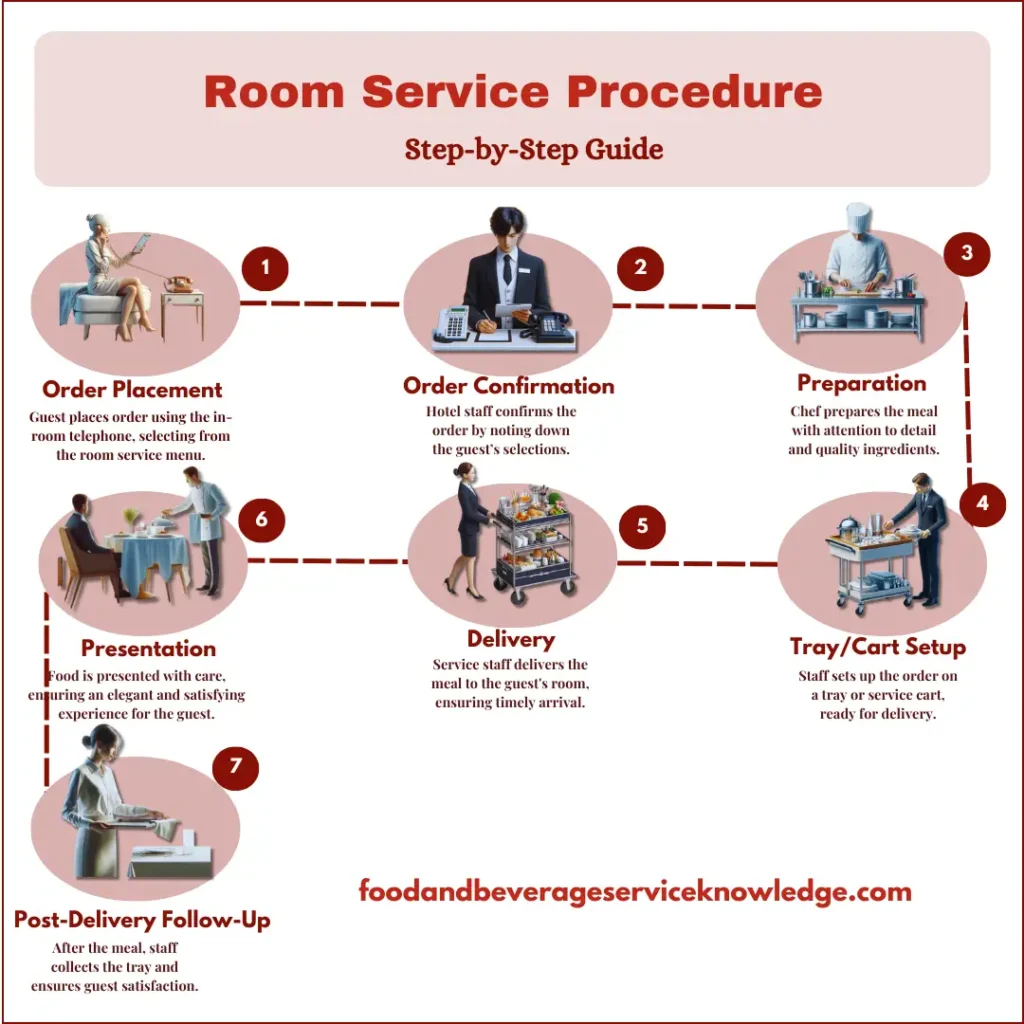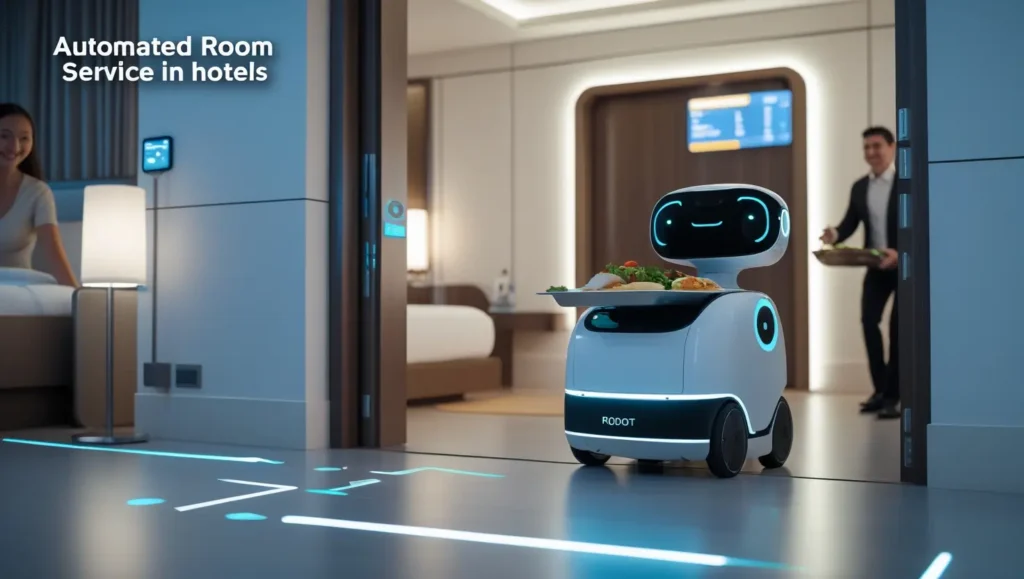In the realm of hospitality, room service stands as a hallmark of luxury, convenience, and personalised food and beverage service. It offers guests the comfort of enjoying meals, drinks, and other amenities without leaving the privacy of their hotel rooms. This service not only enhances the guest experience but also serves as a significant revenue stream for hotels.
What is Room Service?
Room service, also known as in-room dining, refers to the delivery of food and drinks directly to a guest’s hotel room. This service is typically available in hotels, resorts, and cruise ships, allowing guests to order from a menu and have their selections brought to them by hotel staff. The concept emphasises personalised service, catering to guests’ preferences and schedules.
The term “room service” encompasses more than just food delivery; it signifies a commitment to guest satisfaction and comfort. By offering this service, hotels demonstrate their dedication to providing a seamless and indulgent experience, ensuring that guests’ needs are met promptly and efficiently.
Explore the history of room service on Wikipedia to see how this hospitality staple evolved over time.
Room Service Procedure
Room service is a service provided by hotels and resorts where guests can order food and beverages directly to their rooms. It’s designed for comfort, privacy, and convenience—whether it’s breakfast in bed, a late-night snack, or a full-course dinner.
Understanding the room service process helps hotel staff deliver excellent service and ensures a smooth, satisfying experience for the guest.
Below is an infographic showing the step-by-step room service procedure—from order placement to follow-up.

Here’s a step-by-step look at how room service typically works:
1. Order Placement
The process starts when a guest places an order. This can be done in several ways:
- Call the room service or the front desk directly.
- Using an in-room tablet or smart TV.
- Ordering through the hotel’s mobile app or website.
Staff Tip: Be polite, speak clearly, and confirm any details such as food allergies, preferences, or delivery time.
2. Order Confirmation
Once the order is placed, the staff repeats the order back to the guest to ensure everything is correct.
This step includes:
- Confirming the ordered items.
- Mentioning the estimated delivery time.
- Noting any special instructions.
Goal: Avoid mistakes and reassure the guest that their request is being handled professionally.
3. Preparation
The kitchen receives the order and begins preparing the food. During this step, timing is critical—everything must be cooked to perfection and finished right before delivery.
What happens here:
- The kitchen team cooks and plates the meals.
- Beverages are poured and sealed if needed.
- Any special instructions (like no onions or extra sauce) are followed carefully.
Staff Tip: Presentation and temperature are key—everything should look good and arrive hot or chilled as needed.
4. Tray or Cart Setup
Once the food is ready, it’s placed on a tray or cart for delivery. This includes:
- Cutlery, napkins, and condiments.
- Beverages, glasses, and extra items like bread or butter.
- Any special table setup for full-service orders?
Optional: For luxury hotels, the tray may be set like a formal dining table with fine linens, flowers, or candles.
5. Delivery to the Room
A room service attendant or server delivers the order to the guest’s room.
There are two main types of delivery:
- Contact delivery: The server knocks, enters, and sets up the tray or table in the room.
- Contactless delivery: The order is left at the door, and the guest is notified via phone or app.
Staff Tip: Always greet the guest with a smile and a polite tone. Ask where they would like the food placed.
6. Presentation to the Guest
If the guest has ordered full-service dining, the server may help arrange the meal setup—uncovering dishes, pouring drinks, and explaining what’s included.
Good practice:
- Offer to remove the tray lids.
- Ask if the guest needs anything else (e.g., extra napkins or condiments).
- Confirm when to return to collect used items if needed.
7. Post-Delivery Follow-Up
After the meal has been delivered, it’s important to check in with the guest. This can be done with a quick call or message:
- “Good evening, we hope you’re enjoying your meal. If you need anything, please let us know.”
- The hotel may also ask when to collect the tray or dishes.
Goal: Show care and stay available for any further needs.
Want to learn how the restaurant service Procedure works? Read: Sequence of Service in Restaurants: Steps of Table Service in Fine Dining
Types of Room Service
Room service isn’t a one-size-fits-all operation. Depending on the size of the hotel, its clientele, and its level of luxury, room service can take many forms. Understanding the different types of room service helps hotels tailor their offerings to meet guest expectations and operational capabilities.
Here’s a comprehensive look at the most common room service types found in the hospitality industry:
1. Centralised Room Service
In this model, all orders are managed and dispatched from a central kitchen within the hotel. It is most common in mid to large-size hotels with an established food and beverage operation.
Features:
- Streamlined control over food quality and consistency.
- Centralised staffing for order management and preparation.
- Requires efficient logistics to ensure food is delivered hot and on time.
Best suited for: Large hotels and resorts with full-service restaurants.
2. Decentralised Room Service
This type uses satellite kitchens or pantries located on different floors or wings of the hotel. It reduces delivery time and allows for quicker service, especially during peak hours.
Features:
- Faster turnaround times.
- Less strain on a single kitchen during busy periods.
- Higher staffing and equipment costs due to multiple locations.
Best suited for: High-end hotels or sprawling resorts where the distance from the kitchen to the rooms is a concern.
3. Full-Service Room Service
This is the most traditional form of in-room dining, where guests are provided a complete menu featuring appetisers, entrees, desserts, and beverages. It typically involves white-glove service, table setting in the room, and sometimes even a server attending the guest.
Features:
- Luxurious and personalised experience.
- Extensive menu options.
- Often available during limited hours unless it’s a 24/7 operation.
Best suited for: Luxury hotels and VIP guest floors.
4. Limited-Service Room Service
This is a simplified version of full-service, offering a curated menu of easy-to-prepare, high-demand items such as sandwiches, snacks, and beverages.
Features:
- Focus on efficiency and quick preparation.
- Commonly available 24 hours a day.
- Smaller staff requirement.
Best suited for: Business hotels, boutique hotels, and mid-range accommodations.
5. Automated or Contactless Room Service
With the rise of hospitality technology and guest preferences for low-contact experiences, many hotels are now offering tech-driven room service. Orders can be placed through mobile apps, in-room tablets, or even smart TVs, and deliveries are made without direct interaction, sometimes even by robots!

Features:
- Emphasis on hygiene and safety.
- Convenience for tech-savvy guests.
- Integration with digital menus and payment systems.
Best suited for: Modern, tech-forward hotels and post-pandemic operations.
6. Trolley or Gueridon Service
In this model, food is prepared or finished at the guest’s door or inside the room using a service trolley—also known as Gueridon Service. This might include assembling a salad, flambéing a dessert, or pouring drinks in front of the guest for a personalised touch.
Features:
- Adds an element of theatre and exclusivity.
- Enhances the dining experience with a personal touch.
- Requires skilled staff and specialised equipment.
Best suited for: High-end hotels aiming to provide memorable guest experiences.
Learn: Types of Food and Beverage Outlets: A Guide for Hospitality Professionals
Sample Room Service Menu
Breakfast Menu (Available 6:00 AM – 11:00 AM)
Continental Breakfast: Freshly baked croissant, Danish pastry, seasonal fruit, juice, and coffee or tea.
American Breakfast: Two eggs (any style), hash browns, bacon or sausage, toast, fruit, juice, and coffee or tea.
Healthy Start: Greek yoghurt, granola, honey, chia seeds, mixed berries, and a green smoothie.
Pancake Stack: Fluffy pancakes with maple syrup, butter, and optional fruit topping.
Omelette Station: Three-egg omelette with your choice of cheese, ham, peppers, onions, and tomatoes. Served with toast and hash browns.
All-Day Dining (Available 11:00 AM – 11:00 PM)
Club Sandwich: Triple-decker sandwich with turkey, ham, bacon, lettuce, tomato, and mayo. Served with fries.
Caesar Salad: Romaine lettuce, parmesan, garlic croutons, and Caesar dressing. Add grilled chicken or shrimp.
Margherita Pizza: Thin crust pizza topped with tomato sauce, fresh mozzarella, and basil.
Spaghetti Bolognese: Classic Italian meat sauce served over spaghetti noodles with parmesan cheese.
Vegetarian Wrap: Spinach wrap filled with grilled vegetables, hummus, and feta cheese. Served with a side salad.
Dinner Specials (Available 5:00 PM – 10:00 PM)
Grilled Salmon: Fresh Atlantic salmon with lemon butter sauce, served with steamed vegetables and wild rice.
Ribeye Steak (10 oz): Served with mashed potatoes, seasonal vegetables, and choice of peppercorn or mushroom sauce.
Chicken Tikka Masala: Tender chicken cooked in a creamy tomato curry, served with basmati rice and naan bread.
Vegetable Stir-Fry: Mixed vegetables tossed in a soy-ginger glaze. Option to add tofu or chicken.
Desserts (Available All Day)
Chocolate Lava Cake: Warm chocolate cake with a gooey centre. Served with vanilla ice cream.
Cheesecake: Classic New York-style cheesecake with berry compote.
Seasonal Fruit Plate: Freshly sliced fruits, great for a light finish or a healthy snack.
Ice Cream Trio: Three scoops of your choice: vanilla, chocolate, or strawberry.
Beverages
Hot Drinks: Coffee, espresso, cappuccino, hot chocolate, selection of teas.
Cold Drinks: Fresh juices (orange, apple, watermelon), soft drinks, iced tea, and bottled water.
Alcoholic Beverages: House wine (red/white), beer, mini spirits (vodka, gin, whisky). ID required upon delivery.
For a real-world example of a room service menu, check out this sample from Royal Caribbean.View Room Service Menu Sample (PDF)
Want to see how top hotels design their in-room dining menus? Take a look at this in-room dining menu from Hyatt: View Hyatt In-Room Dining Menu (PDF)
Learn different types of menus used in food and beverage service:
- Table d’Hôte Menu Explained: Meaning, Key Characteristics, Examples & More
- À la Carte Menu: Definition, Features, Pros & Cons for Modern Dining
- 17 Course French Classical Menu: Examples & Description
Conclusion
Room service plays a key role in enhancing the guest experience. Whether it’s a full meal or a quick snack, it adds comfort, convenience, and a touch of luxury. By understanding the types, process, and purpose of room service, hotels can better meet guest needs and create memorable stays.
FAQs
Is room service free in hotels?
Usually, no. Most hotels charge for the food and may also include extra fees like delivery charges or service fees. Always check the menu for prices and fees.
How do I order room service in a hotel?
You can order room service by calling the room service number on your room phone, using a hotel app, or placing the order through an in-room tablet or TV system.
Can I get room service late at night?
It depends on the hotel. Many offer 24-hour room service, while others only serve during certain hours. Check the in-room menu or ask the front desk.
Also Read
This article was written by Saswata Banerjee, the creator of Food and Beverage Service Knowledge, based on 8+ years of experience in the hospitality industry.


